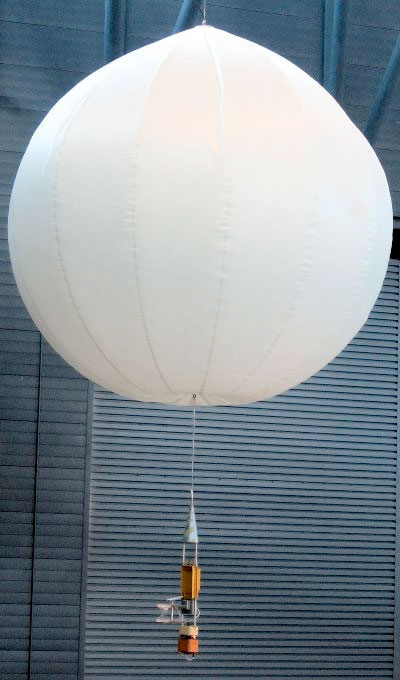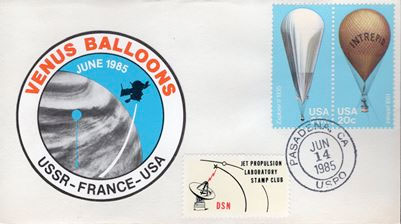Space Cover 425: Vega Venus BalloonOn June 11 and 14, 1985, two instrumental balloons were released from the Soviet VEGA 1 and VEGA 2 spacecraft respectively and deployed in the atmosphere of Venus. The VEGA probes flew by the planet to get a gravity assist on their way to a rendezvous with comet Halley in March 1986.
Drifting with the wind at altitudes of about 34 miles, the balloons traveled one-third of the way around the planet during their 46-hour lifetimes. Sensors on-board the gondolas made periodic measurements of pressure, temperature, vertical wind velocity, cloud particle density, ambient light level, and frequency of lightning.
The data were transmitted to Earth and received at the Deep Space Network (DSN) 64-m stations and at several large antennas in the USSR. Approximately 95 percent of the telemetry data were successfully decoded at the DSN complexes and in the Soviet Union, and were provided to the international science team for analysis.
Very Long Baseline Interferometry (VLBI) data were acquired by 20 radio observatories around the world for the purpose of monitoring the Venus winds. The DSN 64-m subnet, managed by NASA Jet Propulsion Laboratory in Pasadena, was part of a 15-station VLBI network organized by the Centre National d'Etudes Spatiales (CNES) of France. In addition, five antennas of the Soviet network participated. VLBI data from the CNES network was processed at the Jet Propulsion Laboratory.
Each balloon's instruments consisted of (1) an arm carrying thermometers and a velocity anemometer; (2) a module to measure light levels and a pressure sensor; and (3) a package to measure cloud density through light reflection. The sampling rate for most of these instruments was only once every 75 seconds.
The balloons were dropped onto the planet's dark-side and deployed at an altitude of about 31 miles. They then floated upward to their equilibrium altitude. At this altitude, pressure and temperature conditions of Venus are similar to those of Earth, though the planet's winds moved at hurricane velocity and the carbon dioxide atmosphere is laced with sulfuric acid.
The balloons moved swiftly across the night side of the planet into the light side, where their batteries finally ran down and contact was lost. Tracking indicated that the motion of the balloons included a surprising vertical component, revealing vertical motions of air masses that had not been detected by earlier probe missions.
This image shows the Vega balloon probe on display at the Udvar-Hazy Center of the Smithsonian Institution.

The cover at the top of the post has a mixed franking of USA and Jet Propulsion Laboratory Stamp Club "DSN" Space Stamps postmarked Pasadena, California for the second balloon which launched from VEGA 2 on June 14th.













